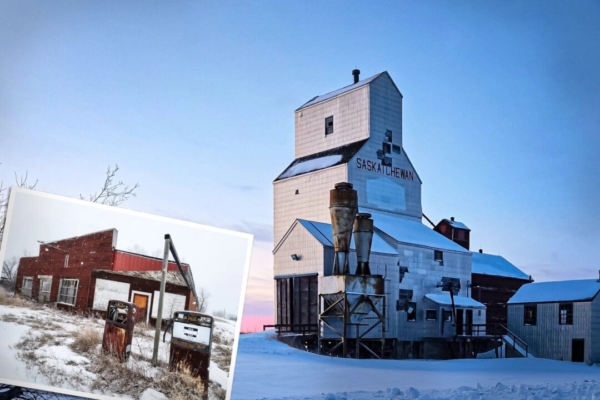Maricris Moresca is a woman of many roles – a full-time mom arranging appointments at a car dealership, an immigrant from the Philippines to Canada, and a survivor. Between working and shuttling her children back and forth from the ice rink, this 35-year-old understated woman from Lipton, Saskatchewan, is an explorer seeking out forgotten places.
As she drives her son and daughter to Lafleche Village for hockey games, Moresca navigates through towns like Ardill, Gravelbourg, and Moose Jaw. Armed with her camera and hockey gear, she heads to Gravelbourg after dropping off her kids, spending hours capturing nostalgic photos.
Moresca told The Epoch Times that the main street of Gravelbourg still retains “the charm of the 1940s.” She found certain places to have a magical allure, such as nearby abandoned granaries and rundown farmhouses.
“It’s like going on an adventure exploring these places,” she said.
The ancient abandoned buildings in Saskatchewan initially caught Moresca’s attention due to their aesthetic qualities: she saw beauty in broken windows, peeling paint, collapsing walls, and caved-in ceilings.
Beneath the weathered textures, unique shapes, and the ghostly effects of light and shadow, the poignant history of these buildings deeply appealed to Moresca’s artistic pursuits. The abandoned homesteads, ghost towns, and granaries she seeks out tell tales of a bygone simple time, memories she revives through her photography.
In the ancient history of Saskatchewan, there is a particular prominence of outdated rural architecture.
Granaries, Moresca says, represent an important part of agricultural history. Documenting these structures helps preserve a record of this history and increases awareness of their historical and cultural significance.
The decline of these granaries mirrors the fate of many abandoned rural buildings.
Once upon a time, granaries stood like sentinels on the prairies, with nearly 6000 in western Canada. Their abundance meant any farmer could drive to a granary and return to the farm in a day. Where granaries stood, hardware stores, markets, post offices, and churches emerged. Soon, a town was born.
However, industrialization rendered this pattern, along with many rural settlements, obsolete. Today, there are fewer than 275 granaries remaining, scattered remnants of once thriving rural communities.
Moresca arrived in Canada in 2019 from Bisinarugna in the Philippines with her children, beginning to explore abandoned spaces after meeting her fiancé, Derek Lutz. Derek showed her old photographs and introduced her to the history of Saskatchewan.
They traced the path of time along old railway maps to abandoned towns where dilapidated granaries still stand. Moresca said, “Most of the towns along the way, even if not abandoned, are gradually dwindling.”
They arrived in the ghost town of Brooking, where there stood a post office from 1911 and subsequent buildings: a three-story hotel, two restaurants, and a bakery. Two granaries were born here.
“The post office closed in 1961, and the granary ceased operations in 1968. Once a bigger town, Radville was established, Brooking began to decline. People and businesses moved to Radville,” Moresca added. “Today, Brooking remains a popular spot for those seeking picturesque landscapes and nostalgic photographs.”
Brooking is now renowned for its eerie nostalgic appearance, with its granaries featured in the 1999 film “Revenge of the Land.”
Following their railway exploration, Moresca began to squeeze in more photography trips into her busy schedule, arranging appointments at local Chevrolet dealerships and shuttling her kids to hockey games, providing her convenience to reach the old buildings in the southern towns of Saskatchewan, where many ancient structures reside.
“Where there is a game, there is a photography opportunity,” she said.
Starting from Lafleche’s hockey rink, a short drive brings Moresca to the ghost town of Ardill (or “Hard Hill”), where she often snaps photos. Passing through a bend is Odessa Village, where she captures several old catalog homes – true emblems of simpler times. These fashionable home kits were pre-designed by big city companies and delivered to customers on the prairies.
“Eaton’s Company was one of the several companies providing plans and home designs. Materials were shipped by railways to the nearest community and then hauled to the construction site,” Moresca explained.
Near Odessa, in the rural municipality of Francis, a weathered spired wooden structure breaks the flat snowy horizon. This is the Christ Lutheran Church, long abandoned by parishioners, captured by Moresca in 2024. She has now become accustomed to encountering abandoned religious buildings on her journeys.
Earlier this month, Moresca and her fiancé ventured to photograph several historic churches on secluded roads in the southeastern part of Saskatchewan. This trip took them to the Park Landscape Ghost Town, where almost only a deserted train station remains, even though not all places they visited were completely abandoned. The towns of Curoki, Margo, Invermay, Lamas, and Nat Mountain thrive – along with their ancient religious and agricultural buildings.
Before meeting Lutz, Moresca, as a single mom, endured immense pressure, often finding herself in what she describes as a “survival mode,” similar to the places she photographs.
“Raising two children in a foreign country is not easy,” she said. Her struggles, she adds, have made her stronger. Now she gives back to society through her photography.
“For me, it’s a wonderful way to preserve their history. I’m glad to document them before granaries and churches disappear,” Moresca said.

